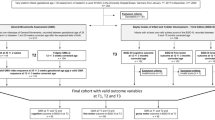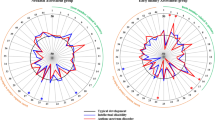Abstract
Background
Preterm infants who do not have fidgety movements at 3 months of corrected age have up to ten times greater risk of developing cerebral palsy or other alterations in motor development, compared to infants who exhibit such movements. The General Movements Assessment (GMA) is a validated tool that may predict the fidgety movement period.
Objective
This study aimed to describe the trajectory of the General Movements Assessment (GMA) during the preterm and writhing movements periods in preterm infants and determine the best time point to predict the fidgety movements period.
Study design
Fifty-two preterm newborns were evaluated by the GMA method. Results: GMA assessment at the age of 5 weeks post term was found the most predictive of neuromotor development disorders in at-risk newborns, with a sensitivity and specificity of 86% and 58%, respectively, and a high negative predictive value (92%) and increased hit ratio (69% accuracy).
Conclusion:
Preterm infants with ≤34 weeks of gestational age have a high prevalence of poor repertoire classifications on the GMA and one single assessment with GMA near the time of NICU discharge seems to be the best time to determine infants who need to be followed more carefully, but the best time point to predict the fidgety movements period was 5 weeks post term.
This is a preview of subscription content, access via your institution
Access options
Subscribe to this journal
Receive 12 print issues and online access
$259.00 per year
only $21.58 per issue
Buy this article
- Purchase on Springer Link
- Instant access to full article PDF
Prices may be subject to local taxes which are calculated during checkout
Similar content being viewed by others
References
Spittle AJ, Orton J, Anderson P, Boyd R, Doyle L. Early developmental intervention programs post hospital discharge to prevent motor and cognitive impairments in preterm infants what’ s new dates text of review synopsis. Cochrane Database Syst Rev. 2015;1:1–107.
Novak I, Morgan C. High-risk follow-up: early intervention and rehabilitation. In: de Vries LS, Glass HC, editors. Handbook of clinical neurology. Cambridge: Elsevier B.V.; 2019. p. 483–510.
Spittle AJ, Lee KJ, Spencer-Smith M, Lorefice LE, Anderson PJ, Doyle LW. Accuracy of two motor assessments during the first year of life in preterm infants for predicting motor outcome at preschool age. PLoS ONE. 2015;10:1–15.
Novak I, Morgan C, Adde L, Blackman J, Boyd RN, Brunstrom-Hernandez J, et al. Early, accurate diagnosis and early intervention in cerebral palsy: advances in diagnosis and treatment. JAMA Pediatr. 2017;171:897–907.
Byrne R, Noritz G, Maitre NL. Implementation of early diagnosis and intervention guidelines for cerebral palsy in a high-risk infant follow-up clinic. Pediatr Neurol. 2017;76:66–71.
Spittle AJ, Boyd RN, Inder TE, Doyle LW. Predicting motor development in very preterm infants at 12 months’ corrected age: the role of qualitative magnetic resonance imaging and general movements assessments. Pediatrics. 2009;123:512–7.
Furtado AD, Vinicius M, Pinto R, Celso L, De Carvalho M, Gasparetto EL. Confiabilidade da análise qualitativa da ressonância magnética do encéfalo em prematuros extremos. Radiol Bras. 2010;43:375–8.
Tomantschger I, Herrero D, Einspieler C, Hamamura C, Voos MC. The general movement assessment in non-European low- and middle-income countries. Rev Saude Publica. 2018;52:1–8.
Einspieler C, Prechtl HFR. Prechtl’s assessment of general movements: a diagnostic tool for the functional assessment of the young nervous system. Ment Retard Dev Disabil Res Rev. 2005;11:61–7.
Peyton C, Yang E, Msall ME, Adde L, Støen R, Fjørtoft T, et al. White matter injury and general movements in high-risk preterm infants. Am J Neuroradiol. 2017;38:162–9.
Oberg GK, Jacobsen BK, Jorgensen L. Predictive value of general movement assessment for cerebral palsy in routine clinical practice. Phys Ther. 2015;95:1489–95.
Noble Y, Boyd R. Neonatal assessments for the preterm infant up to 4 months corrected age: a systematic review. Dev Med Child Neurol. 2012;54:129–39.
Bosanquet M, Copeland L, Ware R, Boyd R. A systematic review of tests to predict cerebral palsy in young children. Dev Med Child Neurol. 2013;55:418–26.
Olsen JE, Allinson LG, Doyle LW, Brown NC, Lee KJ, Eeles AL, et al. Preterm and term-equivalent age general movements and 1-year neurodevelopmental outcomes for infants born before 30 weeks’ gestation. Dev Med Child Neurol. 2018;60:47–53.
Gontijo ML, Cardoso AA, Dittz EdaS, Magalhães LdeC. Evasão Em Ambulatório De Seguimento Do Desenvolvimento De Pré-Termos: Taxas E Causas. Cad Bras Ter Ocup. 2018;26:73–83.
Frônio SJ, Neves TAL, Ferraz TS, Demarchi RS, Vargas ALA. Análise da evasão em serviço de follow-up de recém-nascidos de alto risco. HU Rev Juiz Fora. 2009;35:219–26.
Adde L, Thomas N, John HB, Oommen S, Vågen RT, Fjørtoft T, et al. Early motor repertoire in very low birth weight infants in India is associated with motor development at one year. Eur J Paediatr Neurol. 2016;20:918–24.
Prechtl HFR. Qualitative changes of spontaneous movements in fetus and preterm infant are a marker of neurological dysfunction. Early Hum Dev. 1990;23:151–8.
Stangler S, Huber C, Routh D. Screening growth and development of preschool children: a guide for test selection. New York: MacGraw-Hill Inc.; 1980. p. 51–5.
de Vries NKS, Bos AF. The quality of general movements in the first ten days of life in preterm infants. Early Hum Dev. 2010;86:225–9.
Manacero SA, Marschik PB, Nunes ML, Einspieler C. Is it possible to predict the infant’s neurodevelopmental outcome at 14 months of age by means of a single preterm assessment of General Movements? Early Hum Dev. 2012;88:39–43.
Garcia JM, Gherpelli JLD, Leone CR. The role of spontaneous general movement assessment in the neurological outcome of cerebral lesions in preterm infants. J Pediatr. 2004;80:296–304.
Hadders-Algra M. Putative neural substrate of normal and abnormal general movements. Neurosci Biobehav Rev. 2007;31:1181–90.
Olsen JE, Brown NC, Eeles AL, Lee KJ, Anderson PJ, Cheong JLY, et al. Trajectories of general movements from birth to term-equivalent age in infants born <30 weeks’ gestation. Early Hum Dev. 2015;91:683–8.
Acknowledgements
This research thanks the team of undergraduate students of the Child Performance Assessment Laboratory (Laboratório de Avaliação do Desempenho Infantil—LADIN).
Funding
This work was carried out with the support of the Coordenação de Aperfeiçoamento de Pessoal de Nível Superior (CAPES), Brazil.
Author information
Authors and Affiliations
Contributions
All authors have made substantial contributions to: (1) conception and design, or data collection, or literature review and review, (2) article writing or critical review for important intellectual content, and (3) final version approval to be published.
Corresponding author
Ethics declarations
Conflict of interest
The authors declare no competing interests.
Additional information
Publisher’s note Springer Nature remains neutral with regard to jurisdictional claims in published maps and institutional affiliations.
Rights and permissions
About this article
Cite this article
A. Souza, F., C. L. Nogueira, C., J. Silva, A. et al. Preterm and writhing movements: is it possible to predict fidgety movements in preterm infants?. J Perinatol 41, 2442–2448 (2021). https://doi.org/10.1038/s41372-021-01064-z
Received:
Revised:
Accepted:
Published:
Issue Date:
DOI: https://doi.org/10.1038/s41372-021-01064-z



